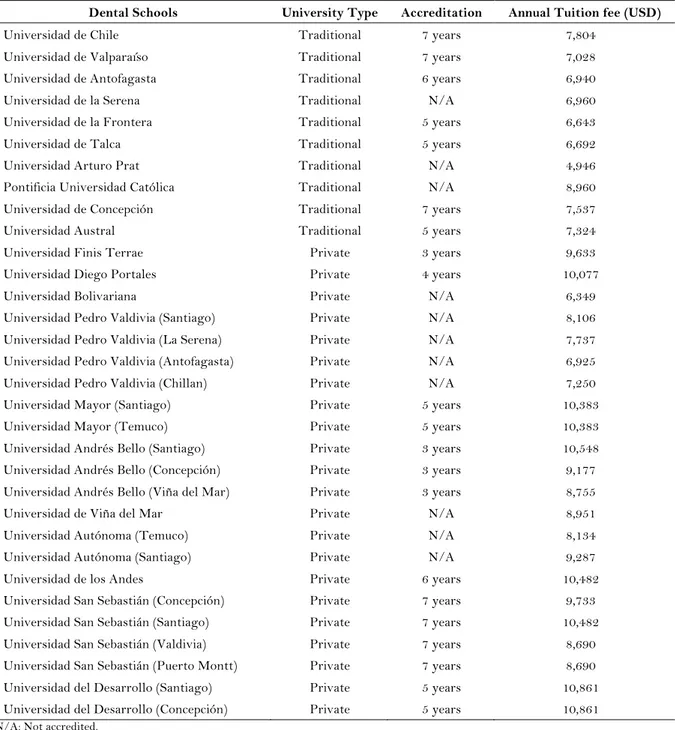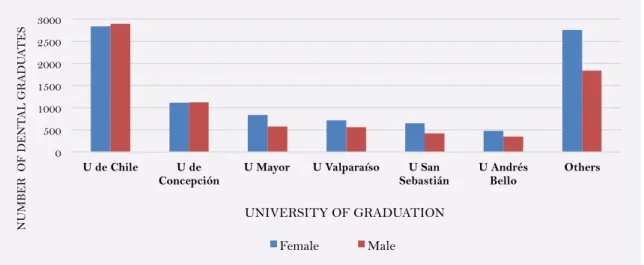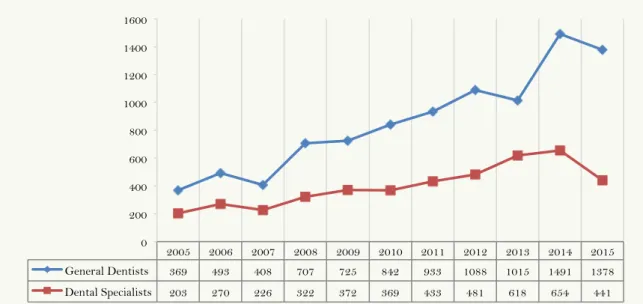ISSN 1519-0501
1
ORIGINAL ARTICLE
The Current Status of Dental Education and the Dental Profession in
Chile
Javiera Guíñez1, Pedro Guajardo2, Ricardo Cartes-Velásquez3,4, Valeria Campos5
1Atacama Health Service, Copiapó, Chile. 2Arauco Health Service, Arauco, Chile.
3Professor, Universidad Autonoma de Chile, Temuco, Chile.
4Professor, School of Dentistry, Universidad Andres Bello, Concepción, Chile.
5Department of Dental Preventive and Public Health, Faculty of Dentistry, University of Concepción, Concepción, Chile.
Author to whom correspondence should be addressed: Dr. Valeria Campos. Department of Dental Preventive and Public Health, Faculty of Dentistry, University of Concepción. Avenida Roosevet #1550, Concepción, Chile. Phone: +56 987690058. E-mail: valeriacamposcannobbio@gmail.com.
Academic Editors: Alessandro Leite Cavalcanti and Wilton Wilney Nascimento Padilha
Received: 11 December 2017 / Accepted: 07 February 2018/ Published: 13 February 2018
Abstract
Objective: To describe the current situation of the dental profession in Chile, including training and workforce issues. Material and Methods: Data were collected from different national institutions, which included information regarding number of current registered dentists, university of graduation, geographical distribution, professional position, additional specialty certifications obtained, the number and characteristics of dental surgeons who work in the public and private sectors, the traditional character of the university, the accreditation status of the undergraduate dental programs and the general population number. Results: Currently there are 32 schools of Dentistry in Chile, of which 21 have their quality certified. There are 19,100 Chilean dentists and 1,727 foreign dentists registered. The number of graduates from private universities has increased significantly. Currently, 2,164 dentists work for MINSAL. Less than a third hold a specialty certification. Forty-five percent of the dental specialists obtained their certification from universities. The current professional ratio is 104 dentists per 100,000 habitants. Conclusion: The number of dentists in Chile has increased progressively during the last years, mainly associated with the opening of new dental schools. Only 28% of the Chilean dental schools have certified their quality for the total duration of the undergraduate program. Regarding the workforce, there is a public/private and geographical inequities in dentists’ distribution.
2 Introduction
In Chile, dental training began in 1888 with a two-year course at the Universidad de Chile [1]. In 1917, the enactment of the Law No. 3.301, recognized the legal status of the dental profession. Two years later, the second undergraduate dental program was created at the Universidad de Concepción [2]. During the last one-hundred years of dental profession, and especially in the last three decades, many changes have occurred in the Chilean higher education system [2,3].
Until 1981 there were 25 universities, known as traditional universities, of which only 16 have state dependency, and the remaining nine are non-profit private organizations. That same year, with the enactment of the General Law on Universities, the number of private universities started to grow. Later, in 1990, the Constitutional Organic Law of Education (Ley Orgánica Consitucional de Educación, LOCE) established a framework for the Chilean higher education system. The aims of LOCE were to increase student enrollment, which had dropped by 30% since 1975, to diversify the higher education system, and to stimulate competition between institutions in order to increase the professional/technical workforce in the country [3,4].
In 1997 there were five undergraduate dental programs in Chile, all of them in traditional universities. That year initiated the first undergraduate dental program in a private university, Universidad Mayor, and since then the increase in the number of dental schools has been exponential [5].
In 2006, the National Accreditation Commission (Comisión Nacional de Acreditación, CNA) [5,6] was created in order to ensure minimum quality standards of higher education institutions and programs. However, institutions and programs are not obligated to comply with the CNA certification. Thus the quality of the teaching-learning process in many institutions and programs (including dental programs) is not guaranteed [7,8].
In Chile there are three pathways for dental specialty certification: Autonomous National Corporation of Dental Specialties Certification (Corporación Nacional Autónoma de Certificación de Especialidades Odontológicas, CONACEO), Universities, and Health Services dependent from the Ministry of Health (Ministerio de Salud, MINSAL).
As the Law 20.261 established a compulsory national examination for medical graduates (passing it is a pre-requisite to practice as a physician in the public health system), it has been of great interest to develop a compulsory national examination for dental graduates in order to ensure minimum competence standards for dentists in Chile [9].
3 number of dentists work mainly in independent small dental offices and health centers, not covered by FONASA nor ISAPRE [10].
The aim of this study is to describe the current situation of the dental profession in Chile, including training and workforce issues.
Material and Methods
Study Design and Data Collection
This is a retrospective and descriptive study. The data were collected from the following institutions: National Institute of Statistics (Instituto Nacional de Estadística, INE), a technical institution responsible for statistics and official censuses in Chile; National Registry of Individual Health Providers (Registro Nacional de Prestadores Individuales de Salud, RNPI), an organization whose main objective is to safeguard the quality assurance of medical care; The Undersecretary of Health Care Networks (Subsecretaría de Redes Asistenciales - SRA), part of the Ministry of Health, coordinates the public health care coverage in the entire country; the Ministry of Education (Ministerio de Educación, MINEDUC); and CNA.
The data collected included information regarding: number of current registered dentists, university of graduation, geographical distribution, professional position, and specialty certification were obtained from RNPI; the number and characteristics of dental surgeons who work in the public sector were obtained from the SRA; the private and traditional character of the university, the annual tuition fees, and the accreditation status (years of accreditation) of the undergraduate dental programs were obtained from CNA and MINEDUC; and the population number was obtained from the INE.
Statistical Analysis
For the analysis of data, the SPSS (Statistical Package for the Social Sciences for Windows - version 20.0) was used. Descriptive statistics (absolute distributions, percentages and mean) was also used.
Ethical Aspects
It has been conducted in full accordance with the World Medical Association Declaration of Helsinki and approved by the Bioethics and Investigation Committee of the Faculty of Dentistry, University of Concepción (CIYBNº069/17). The use of Patient Informed Consent was not applicable as data were obtained from Public State Databases, but all data was anonymized and coded before analysis.
Results
4
Table 1. Current Chilean dental schools.
Dental Schools University Type Accreditation Annual Tuition fee (USD)
Universidad de Chile Traditional 7 years 7,804
Universidad de Valparaíso Traditional 7 years 7,028
Universidad de Antofagasta Traditional 6 years 6,940
Universidad de la Serena Traditional N/A 6,960
Universidad de la Frontera Traditional 5 years 6,643
Universidad de Talca Traditional 5 years 6,692
Universidad Arturo Prat Traditional N/A 4,946
Pontificia Universidad Católica Traditional N/A 8,960
Universidad de Concepción Traditional 7 years 7,537
Universidad Austral Traditional 5 years 7,324
Universidad Finis Terrae Private 3 years 9,633
Universidad Diego Portales Private 4 years 10,077
Universidad Bolivariana Private N/A 6,349
Universidad Pedro Valdivia (Santiago) Private N/A 8,106
Universidad Pedro Valdivia (La Serena) Private N/A 7,737
Universidad Pedro Valdivia (Antofagasta) Private N/A 6,925
Universidad Pedro Valdivia (Chillan) Private N/A 7,250
Universidad Mayor (Santiago) Private 5 years 10,383
Universidad Mayor (Temuco) Private 5 years 10,383
Universidad Andrés Bello (Santiago) Private 3 years 10,548
Universidad Andrés Bello (Concepción) Private 3 years 9,177
Universidad Andrés Bello (Viña del Mar) Private 3 years 8,755
Universidad de Viña del Mar Private N/A 8,951
Universidad Autónoma (Temuco) Private N/A 8,134
Universidad Autónoma (Santiago) Private N/A 9,287
Universidad de los Andes Private 6 years 10,482
Universidad San Sebastián (Concepción) Private 7 years 9,733
Universidad San Sebastián (Santiago) Private 7 years 10,482
Universidad San Sebastián (Valdivia) Private 7 years 8,690
Universidad San Sebastián (Puerto Montt) Private 7 years 8,690
Universidad del Desarrollo (Santiago) Private 5 years 10,861
Universidad del Desarrollo (Concepción) Private 5 years 10,861
N/A: Not accredited.
Until May 2016, 19,100 dentists were registered in the RNPI, of which 10,431 are women, corresponding to 54.6% of the total number of registrations. The average age of Chilean dentists is 38.4 years, with the average age for women of 37.3 years, and men 39.2 years.
The highest number of dentists graduated from Universidad de Chile and Universidad de Concepción. The distribution by home university and sex is shown in Figure 1. There are 1,727 registered foreign dentists, most of them from Latin American countries, Colombia being the top country of origin with 761 registered dentists followed by Ecuador with 374.
5
Figure 1. Dentist distribution according to university of graduation.
Figure 2. Distribution of dentists according to graduation year and type of University from 2001 to 2015.
Figure 3 shows the geographical distribution of the 2,164 MINSAL-employed dentists.
Figure 3. Geographic distribution in Chile of dentists employed by MINSAL.
6 As of May 2016, 26.6% of dentists accredited specialty, corresponding to 5,083 dentists, of which 491 have more than one specialization, which represents 9.6%. The number of specialists certified by year is shown in Figure 4.
Figure 4. Comparison between number of dentists and specialists registered with the RNPI, according to graduation year.
Of the dental specialists, 45.2% obtained their certification from Universities, 40.1% from CONACEO and 14.7% by Health services. Figure 5 shows the distribution of dentists with recognized dental specialties in Chile.
Figure 5. Distribution of dentists with recognized dental specialties in Chile.
7 100,000 inhabitants, followed by Biobio region with 19 dentists per 100,000 inhabitants, and the metropolitan region has 7.6 dentists per 100,000 inhabitants.
Discussion
In Chile, dentistry has been affected by a lack of regulation in higher education. Up to now, from the 32 dental schools, 11 have not certified their quality and only nine have a certification equal to or greater than the total duration of the undergraduate program (6-years). This means that 71.8% of universities that offer the undergraduate program of dentistry do not meet adequate standards of accreditation throughout the teaching process.
With respect to tuition fees, there are marked differences between universities, from USD $ 4,946 to USD $ 10,861 annually. It must be considered that there has been an exponential growth in the cost of tuition, from an average of USD $ 3,900 in 1997 to USD $ 9,800 in 2011 [11].
Among the limitations of this study is the calculation of the current number of practicing dentists, as there is no single service that collects the total number of these active health professionals. The RNPI is the only entity in Chile that allows for the estimation of the quantity and characterization of these professionals, which presents limitations, since before 2009 the registration of their new graduates was not mandatory for Universities [5], as it was voluntary until that year, except for the registration for those who work in the public sector dependent on MINSAL, in which case it has always been a pre-requisite.
The highest number of registered graduates (33%) comes from the Universidad de Chile followed by Universidad de Concepción with 13%. The largest number of graduates being from the University of Chile can be explained as this is the oldest school of Dentistry and because up to the year 1980 students from other universities had to take the degree exam at the University of Chile in order to opt for a professional degree certificate [5]. In third place, comes the first private university, Universidad Mayor, with 8% of graduates, which could be explained as it was the first private university to offer this undergraduate program and because it has two campuses, one in Temuco and another in Santiago, that offer it [5,12].
The significant increase in the number of graduates from private universities is related to a substantial increase in the number of dental schools from these universities since 2009, offering the undergraduate program in more than one campus, such as the Universidad Mayor, Universidad Del Desarrollo and Universidad Autónoma with two campuses, Universidad Andrés Bello with three and finally, Universidad San Sebastián and Universidad Pedro de Valdivia with four. At a Latin American level, the general overview is similar, with an increase in the number of vacancies to study dentistry, with no clear health or educational planning that justifies it [12,13].
8 dentists are from Colombia and Ecuador; this could be associated with a treaty of bilateral agreement within these countries for the recognition of professional qualifications obtained abroad.
In Chile the 5,574 specialty certifications correspond to 5,083 specialists, this difference is attributed to the double or triple specialty of some professionals. However, it should be noted that the RNPI does not account for the 70 specialists in public dental health, a specialty recognized by the American Dental Association (ADA) [15].
The exponential increase of specialty certification could be due to newly admitted dentistry students who have already internalized the idea that holding a specialty certification gives them more prestige, especially in certain areas [15,16].
Regarding the workforce, there also has been an exponential growth in the dentist/population ratio, a ratio of 80.2 dentists per 100,000 inhabitants [5], and in 2016, according to our data, this ratio has increased to 104. This prospect is not very encouraging, as it is estimated that the dental workforce will increase up to 42,428 dentists by 2025, with a ratio of one dentist per 450 inhabitants expected [11].
Furthermore, previous authors show a large inequity distribution [5], as this ratio in the public health system is 27.3, versus 254.8 in the private system. Regrettably, we do not hold the data of the total number of dentists that work in the public sector so we are unable to update and compare the ratio that was calculated earlier.
In addition to the public/private inequities in dentists' distribution, there are also geographical inequities. The Metropolitan and the Biobio region concentrate 45% of the dentists dependent on MINSAL and the two most remote regions (The Arica and Parinacota region and the Magallanes region) represent only 2.5%. It is important to highlight that though the Aysén region holds one of the lowest number of dentists, it has the highest dentist to population ratio and the Metropolitan who holds the highest number of dentists, it has the lowest dentist to population ratio. However, this number does not consider those dentists employed by other State services such as Municipalities, the Army, Public Universities, and other minor services.
An improvement in the oral health of the population would be expected following the increase in the number of dentists in Chile. However, this has not happened, since there is still a deficit of dentists in the public system. As previously reported the increase of the dental workforce had has no impact on the access to dental care [13]. It must be considered, according to MINSAL data, that the number of dental consultations is on average 0.69 visits per capita per year, when the recommendation is at least 2 visits per year [17].
9 Future research must focus on the assessment of: the dental training quality, both under- and post-graduate, the impact of dentists/population ratio on national/regional oral health indexes, the work-related quality of life of Chilean dentists, and the reasons why about two thousand students yearly choose a career in dentistry despite the oversupply of dentists.
Conclusion
During the last years there has been a progressive increase in the number of dentists in Chile associated mainly with the opening of new dental schools. Only 28% of the Chilean dental schools have certified their quality for the total duration of the undergraduate program. Regarding the workforce, there is public/private and geographical inequities in dentists distribution.
References
1. Valdenegro R, Caro C, Cruz R, Diaz SN, Peters EB, Ramirez HS. History of university education in dentistry and social role of dentists in Chile. Rev Educ Cienc Salud 2014; 11(1):54-60.
2. Ramirez Skinner H. And what was there before Fauchard? Dentistry in caverns, temples, hospitals and universities. Rev Clin Periodoncia Implantol Rehabil Oral 2012; 5(1):29-39. doi: 10.4067/S0719-01072012000100006.
3. Cruz-Coke R. The evolution of Chilean universities from 1981 to 2004. Rev Méd Chile 2004; 132(12):1543-9. doi: 10.4067/S0034-98872004001200014.
4. Alcota M, Ruiz P, González, FE. Dental programs in the current context of Chilean higher education. Int J Odontostomat 2016; 10(1):85-91. doi: 10.4067/S0718-381X2016000100014.
5. Moscoso-Matus K, Smok P, Botto AM. Characterization of dentists registered in the National Register of Individual Health Providers, Chile. Rev Clin Periodoncia Implantol Rehabil Oral 2016; 9(1):42-7. doi: 10.1016/j.piro.2015.09.011.
6. Cancino VC, Schmal RS. University Accreditation System in Chile: What have we come?. Estud Pedagóg 2014; 40(1):41-60.
7. OCDE/Banco Mundial. Revisión de políticas nacionales de educación: La Educación Superior en Chile 2009, OECD Publishing. doi: 10.1787/9789264051386-en.
8. Espinoza O, Gonzalez LE. Access to higher education in Chile: A public vs. private analysis. Prospects 2013; 43(2):199-214. doi: 10.1007/s11125-013-9268-8.
9. Fuentes J, Silva M, Llermaly S. Dentistry National Exam. Bibliographic review of mechanisms. Int J Odontostomat 2014; 8(1):125-31.
10. Laurell AC, Ronquillo JH. The Second Health Reform. Insurance and payer-provider split. Salud Colectiva 2010; 6(2):137-48.
11. Cartes-Velásquez RA. Exponential growth of dental schools in Chile: Effects on academic, economic and workforce issues. Braz Oral Res 2013; 27(6):471-7.
12. Carrizo A. Dentists’ training in Chile and some Iberoamerican countries. Considerations for education, health and job. J Oral Res 2014; 3(2):119-22.
13. Saliba NA, Moimaz SA, Garbin CA, Diniz DG. Dentistry in Brazil: Its history and current trends. J Dent Educ 2009; 73(2): 225-31.
14. Lastra J. La migración de médicos latinoamericanos a Chile en las últimas décadas. Rev Chil Salud Publica 2006; 10(1):52-9.
15. Navarro-Mora M, Cartes-Velásquez R. Expectations of professional specialization in dental students. Literature review. Rev Estomatol Hered 2015; 25(2):158-66.
16. Dhima M, Petropoulos VC, Han RK, Kinnunen T, Wright RF. Dental students perceptions of dental specialties and factors influencing specialty and career choices. J Dent Educ 2012; 76(5):562-73.


